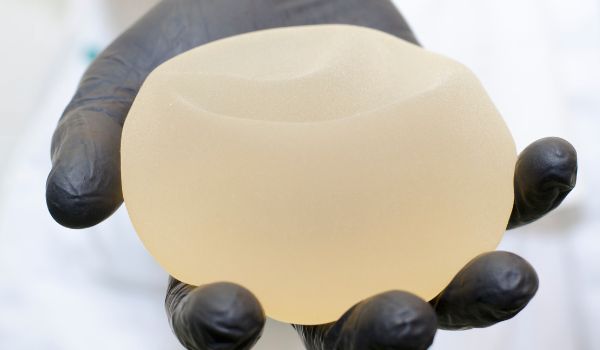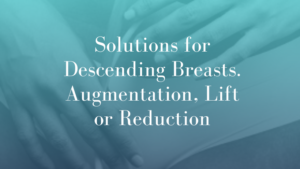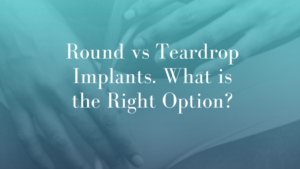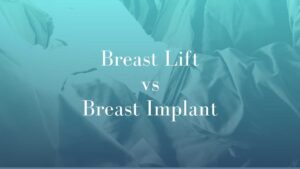Breast Implant-Associated Anaplastic Large Cell Lymphoma
- Interested in finding out more details about BIA-ALCL?
- Thinking about getting an en-bloc capsulectomy?
- Wondering whether you should be concerned about BIA-ALCL?
Breast implants are some of the most tested types of prostheses in the entire history of medicine. Extensive studies have proved that serious complications are very rare. One concerning complication that came to the surface in 2010 is Breast Implant-Associated Anaplastic Large Cell Lymphoma also known as BIA-ALCL. It is a rare form of non-Hodgkin’s lymphoma that can develop around breast implants and has been a topic of interest in the plastic surgery world.
The research to date isn’t conclusive and researchers are learning more and more about the condition. Till now, we know that BIA-ALCL is exclusive to textured implants and typically arises in about 6 to 12 years post-surgery. We also know that with early capsule and implant removal is about 100% treatable. In this article, we are going to discuss the latest BIA-ALCL updates 2022. It will help you learn about the causes, possible risks, prevention, and treatment options.
Dr Michael Kernohan is a renowned specialist plastic surgeon performing breast surgery in Sydney’s Southwest Suburbs and the Southern Highlands. He is committed to delivering optimal results to his patients.
Take the Quiz
What is BIA-ALCL?
BIA-ALCL is a rare immune-cell cancer that is found in the breasts and is linked to textured implants. The condition presents itself as a seroma which is essentially a collection of fluid near the breast implant. It typically leads to considerable pain, deformity or a tumour in the armpit/breast. If you receive an early diagnosis, BIA-ALCL is nearly always curable.
History of BIA-ALCL
In 1997, the first case of BIA-ALCL was reported. Since then, we have witnessed an increase in the number of reports from all around the world. The plastic surgery community acknowledged the relationship between BIA-ALCL and textured implants in 2011. Within a few years, researchers were able to spot that 85% of the BIA-ALCL were caused by Allergan’s Biocell Implants. The company issued a worldwide recall in the year 2019. Every woman who got those implants got a free smooth implant replacement. To this date, not a single case of BIA-ALCL is reported with smooth implants.
Facts about BIA-ALCL
- The total number of reported cases of VIA-ALCL is 994
- The number of deaths related to this condition is 37
- In 2020, no death caused by BIA-ALCL was reported
- The risk of BIA-ALCL is 1 in every 2500 for textured implants
- No BIA-ALCL cases have been reported with smooth implants
- 85% of BIA-ALCL cases are with Allergan Biocell implants
- With early diagnosis, BIA-ALCL is nearly always curable
BIA-ALCL Symptoms Update
The symptoms of BIA-ALCL have been known for quite some time. The latest research hasn’t added anything new in regards to the symptoms. The most common symptoms associated with BIA-ALCL are seroma in the breast, breast pain, palpable breast mass, breast deformity, palpable armpit nodules, swelling, and rashes.
When to See a Surgeon?
If you are noticing even one of these symptoms, it is time to book a consultation with a plastic surgeon as soon as possible. There is quite a high chance that these symptoms are a result of an implant rupture or contracture. The evaluation of the surgeon is absolutely essential to rule out cancer.
Click to Download Dr Michael Kernohan’s Cosmetic Breast Surgery Guide
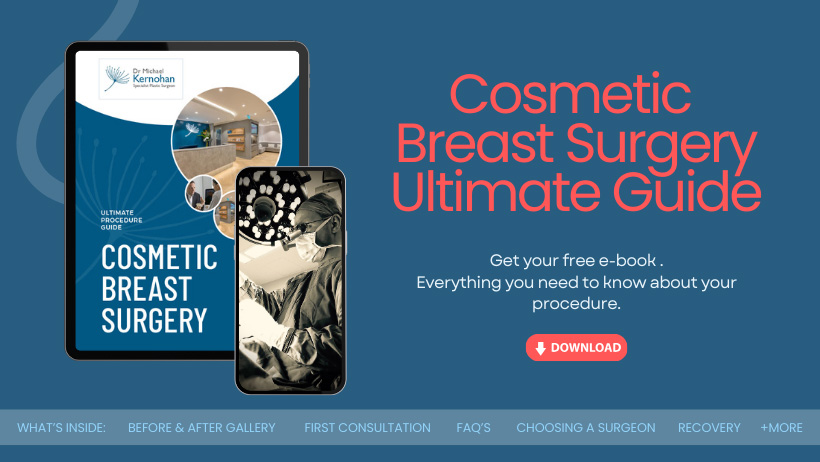
"*" indicates required fields
New Insights about BIA-ALCL
Researchers aren’t still sure how the textured implants cause it. There are some theories in this regard. One of the key theories suggests that BIA-ALCL is caused by chronic inflammation that turns immune cells malignant. In some cases, genetics also come into play and increase the risk.
Chronic Inflammation
This theory is accepted by most doctors and surgeons. Chronic inflammation results in BIA-ALCL. The inflammation leads to mutation of immune cells till they become cancerous. BIA-ALCL is linked with textured implants only which supports this theory. These implants have a higher surface area, and can be colonised with bacteria. As per researchers and doctors, this is how it begins- during the breast augmentation, the bacteria can come in contact with the implant. This can cause bacteria to multiply and form a biofilm on the implant. Chronic inflammation will form around the implant. The malignant changes in the immune cells will lead to BIA-ALCL. As per certain other theories, silicone might lead to inflammation. Certain theories suggest that viruses also contribute to the formation of this condition.
Where Does the Bacteria Come From?
The skin and breast tissue are all loaded with residing bacteria. When they come in contact with your implant, it will lead to infection, BII, capsular contracture, and BIA-ALCL. Certain studies suggest that there isn’t a difference between bacteria in BIA-ALCL patients and non-cancer patients.
All the theories lead to the conclusion that this condition is based on your own immune response, genetics, and your individual body’s reaction to colonising bacteria. Regardless, bacteria is still an initiator of inflammatory response. That is why sterility is a major factor in preventing the cancer. This is one of the prime reasons why surgeons around the world follow a 14 point plan.
What Is the 14-Point Plan
The 14-point plan is designed to ensure maximum sterility while performing a breast augmentation surgery and prevent any bacterial colonisation. The plan involves the use of nipple shields, Keller funnels, changing the gloves regularly, use of antibiotics, betadine wound irrigation, IV antibiotic administration, and others. The goal is to make bacterial colonisation negligible.
A study performed in 2017, on 42,000 textured biocell implants indicated that there were no cases of condition in any of them. As per the statistics, the expected number of BIA-ALCL cases should have been at least 15. However, in this case, the number was zero. This study indicated that technique and sterility play an important role in preventing BIA-ALCL. Hence, it is crucial to stick to the 14 point plan.
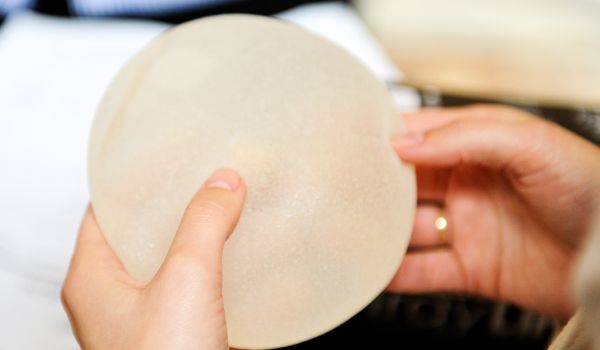
Updates for Asymptomatic Patients
Asymptomatic Patients are those who have no associated symptoms. There has been a constant debate in the plastic surgery community on dealing with BIA-ALCL, especially in the case of textured implants. If you have gotten textured implants, you might be considering the following questions:
- Should I replace my textured implants with a smooth replacement?
- Should I be getting a capsulectomy?
- Is en-bloc removal necessary for my health?
- Should I remove my textured implants?
The quest of removing textured implants is essentially a matter of risk over benefits. The risk of getting BIA-ALCL is very low and the death ratio is even lower. That is why a lot of people wonder whether they should get their textured implants replaced or removed if they don’t have any associated symptoms.
This decision requires thorough examination and discussion with a plastic surgeon. During the discussion, it is important to analyse the risks of the surgery, possible cosmetic outcomes and the risks associated with BIA-ALCL. If you have had Allergan Biocell implants, the company offers free replacements. Hence, finances won’t be a problem here.
Consider the following before making a final decision: age of implants, your age, any breast implant-related complications, warranty, the brand of implants and insurance coverage.
So far, not a single health authority recommends removing implants if you don’t have any symptoms of BIA-ALCL. Breasts implant whether they are textured or not are still considered to be safe prostheses. As per the current data, the low risk of BIA-ALCL doesn’t justify urging for the removal of implants.
However, those patients who do wish to get their implants removed should be offered an explantation surgery.
Research Regarding Capsulectomy
The research suggests that prophylactic removal of the capsule isn’t required if you don’t have BIA-ALCL. This is due to the fact that it carries a lot of avoidable risks such as bad cosmetic outcomes, breast deformity, asymmetry, infection, hypersensitivity, pain, hematoma, lung trauma, nerve injury, blood clots, surgery and anaesthesia-related risks. The surgeon will perform a capsulectomy when there is a proven case of BIA-ALCL. Most surgeons keep the capsule safe and take a biopsy to be very safe.
Getting “EN-BLOC” Breast Implant Removal
Nowadays, the term ‘en-bloc’ is used quite frequently amongst patients. Some women come in requesting an en-bloc removal with photo proof. Most of them don’t know what it actually means, the risk it carries and the fact whether it is needed or not. Some surgeons have capitalised on this trend and market themselves as en-bloc experts and even more patients fall victim to their advertising.
The removal of a breast implant along with the removal of the surrounding fibrous tissue capsule in one piece is referred to as ‘en-bloc’. You should know that it is unnecessary and won’t impact the outcome of preventing and treating BIA-ALCL. This is a marketing term used widely. Plus, you don’t actually need capsulectomy if you don’t actually have BIA-ALCL.
Updates Regarding Diagnosis and Treatment
BIA-ALCL is highly treatable early on. If you catch it in the early stages, it is nearly always curable.
The latest recommendations for the diagnoses and treatments as of 2022 are as follows:
- Patient education is the basis of BIA-ALCL treatment. Each plastic surgeon should convey the risks associated with BIA-ALCL and how to spot symptoms early on.
- Surgical removal of implants with total capsulectomy is regarded as a key treatment for BIA-ALCL. It can completely cure cancer if the condition is detected early on.
- Patients can get an en-bloc removal despite the fact that it isn’t necessary and won’t impact the outcome of the surgery.
- Once the textured implants are removed, patients can get smooth-surfaced implants to maintain the results of the surgery.
Pathology testing is required. All the samples must be sent to pathology. It isn’t covered by insurance in most cases.
How Likely Is BIA-ALCL?
Every patient who has undergone breast augmentation wants to know this. It is important to note that BIA-ALCL is quite recent. Different countries report different rates of BIA-ALCL. The advances in diagnosis and screening lead to the discovery of more and more patients every year. In the year 2008, the risk was supposedly 1 to 3 million women. Today, we know that it is more common than that figure.
The risk of getting BIA-ALCL ranges between 1 in 2,200 and 1 in 300,000 cases. In Australia alone, about 55 cases were identified in the year 2016. As per TGA, the risk is 1 in 2,500 to 1 in 25,000 textured implant patients.
It is important to note that 85% of the reported cases were exclusive to Allergan Biocell breast implants. If you have another brand of implants, the chances of getting BIA-ALCL are pretty slim.
Do I Need to Worry?
Despite all the recent concerns regarding BIA-ALCL, breast implants are still considered to be very safe.
If you are getting smooth implants, BIA-ALCL shouldn’t be a subject of concern for you. This is because the condition is specific to textured implants. Even if you have or are getting textured implants, the risk of BIA-ALCL is very low. 85% of BIA-ALCL are related to biocell implants which are suspended as we talk. In order to put things into perspective, let us tell you that the risk of surgery and anaesthesia complications is a lot higher than BIA-ALCL.
Lastly, you need to be well aware of the risks of getting breast augmentation. Make sure to follow up with the surgeon regularly to ensure that everything is alright. An experienced plastic surgeon will help you make the right choice for your looks and your health.
